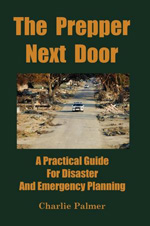For an old-school prepper, it’s borderline heresy to say you prefer the 5.56 mm to the 7.62 mm NATO. The heavier caliber is more effective in stopping vehicles and penetrating barricades and body armor. Expert marksman can hit targets at a greater distance.
When the military adopted the 5.56 mm, one of the surprising reasons was that at greater distances, aimed fire was found to be no more effective than randomly taken shots. Military marksman didn’t like hearing that. But it was statistically incontrovertible. In the hands of the average soldier, a battle rifle could be effectively employed to about 300 yards max. Being within 100 yards was even better.
It’s true; benchrest shooters and snipers can shoot groups as tight as 1.5 inches at 1,000 yards (the last I heard the record was about 1.4 or so inches for a five shot group). But, that’s exceptional and has little bearing to most of us.
As preppers, if we can use a defensive rifle out to 100 yards, that should cover nearly all WROL situations, short of war. Within that distance, the 5.56 mm is adequate.
Terrain limits range. As small groups, it’s impossible to know if a stranger hundreds of yards away is a threat. Even if you had the rifle skill, you can’t just start knocking off strangers 600 yards away.
“But, it can’t be adequate! It’s not adequate for deer! How can it be OK for defense?” some ask. That the 5.56 mm is considered acceptable for defense, but inadequate for deer hunting is something to ponder. There’s no question the 7.62 mm NATO is an adequate deer round.
With deer, the worry is that the light high-velocity 223 bullet will disintegrate on impact, causing a horrible surface wound, but fail to penetrate deeply enough to humanly kill the deer. This is most likely to happen if the bullet hits heavy bone, like a shoulder.
Some big-game hunters like a quartering shot that goes though the shoulder to immobilize the animal. It’s crucial that the caliber be adequate. This is why some Alaskan hunters who shoot moose and really big bear like the 338 Winchester Magnum with heavy bullets. It will reliably smash through the shoulder.
Deer run around on four legs and can present a broadside shot where the shoulder is hit. A human attacker is on two legs. If they’re coming right at you, they’re pretty vulnerable, unless they have body armor. What if you do hit the shoulder with a side shot?
As with the deer, the bullet will probably fail to penetrate into the vital organs and you’ll only wound the attacker. Very few people shot in the side of the shoulder with a 5.56 mm will continue to attack you.
There are rare people who could have their shoulder blown apart who would use their remaining arm to sling their rifle over a log or other support and shoot you. It could happen. But it’s not very likely.
Offsetting the lack of absolute stopping power, the 5.56 mm has some big advantages. The ammo is lightweight, so more can be carried. The smaller caliber is more shootable. It’s easier to get off more accurately aimed rapid shots.
Some old-timers were quick to criticize the M-16s reliability. That doesn’t apply as much to today’s AR-15s. In Vietnam, the M-16 got a bad reputation for failing to function. Many shooters chalk that up to those soldiers not knowing how to properly maintain the rifle. Another factor: the chambers rusted in the jungle conditions. Many modern weapons have chrome-lined chambers and barrels to keep rust at bay.
The one thing I agree with is that “plastic” rifles just aren’t as good-looking as rifles built out of solid wood and steel. Even some old-timers like their bolt action rifles stocked in fiberglass now, because fiberglass stocks are impervious to weather.
***
For those who like Mini-Maglite flashlights, there is a new “Mini Maglite LED Pro” which is getting good reviews:
Here’s a story about prepping your pets for a hurricane
In some hurricane areas, the government is offering free pet microchips. If your pet becomes lost, the microchip will ID him and see he is safely returned to you.
Want to be on Doomsday Preppers? Eat an Iguana.
